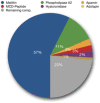Can Bee Venom Be Used as Anticancer Agent in Modern Medicine?
- PMID: 37509375
- PMCID: PMC10378503
- DOI: 10.3390/cancers15143714
Can Bee Venom Be Used as Anticancer Agent in Modern Medicine?
Abstract
Honey bee venom in its composition contains many biologically active peptides and enzymes that are effective in the fight against diseases of various etiologies. The history of the use of bee venom for medicinal purposes dates back thousands of years. There are many reports in the literature on the pharmacological properties of bee venom and/or its main components, e.g., anti-arthritic, anti-inflammatory, anti-microbial or neuroprotective properties. In addition, both crude venom and melittin exhibit cytotoxic activity against a wide range of tumor cells, with significant anti-metastatic activity in pre-clinical studies. Due to the constantly increasing incidence of cancer, the development of new therapeutic strategies in oncology is a particular challenge for modern medicine. A review paper discusses the various properties of bee venom with an emphasis on its anticancer properties. For this purpose, the PubMed database was searched, and publications related to "bee", "venom", "cancer" from the last 10 years were selected.
Keywords: apoptosis; bee venom; cancer; melittin; tumor.
Conflict of interest statement
The authors declare no conflict of interest.
Figures



Similar articles
-
Bee Venom Components as Therapeutic Tools against Prostate Cancer.Toxins (Basel). 2021 May 7;13(5):337. doi: 10.3390/toxins13050337. Toxins (Basel). 2021. PMID: 34067049 Free PMC article. Review.
-
Pharmacological properties and therapeutic potential of honey bee venom.Saudi Pharm J. 2023 Jan;31(1):96-109. doi: 10.1016/j.jsps.2022.11.008. Epub 2022 Nov 15. Saudi Pharm J. 2023. PMID: 36685303 Free PMC article. Review.
-
Therapeutic Potential and Mechanisms of Bee Venom Therapy: A Comprehensive Review of Apitoxin Applications and Safety Enhancement Strategies.Pharmaceuticals (Basel). 2024 Sep 14;17(9):1211. doi: 10.3390/ph17091211. Pharmaceuticals (Basel). 2024. PMID: 39338374 Free PMC article. Review.
-
Bee Venom: From Venom to Drug.Molecules. 2021 Aug 15;26(16):4941. doi: 10.3390/molecules26164941. Molecules. 2021. PMID: 34443529 Free PMC article. Review.
-
Anticancer Activity of Bee Venom Components against Breast Cancer.Toxins (Basel). 2022 Jul 5;14(7):460. doi: 10.3390/toxins14070460. Toxins (Basel). 2022. PMID: 35878198 Free PMC article. Review.
Cited by
-
Harnessing the power of bee venom for therapeutic and regenerative medical applications: an updated review.Front Pharmacol. 2024 Jul 18;15:1412245. doi: 10.3389/fphar.2024.1412245. eCollection 2024. Front Pharmacol. 2024. PMID: 39092234 Free PMC article. Review.
-
Bee Venom: Composition and Anticancer Properties.Toxins (Basel). 2024 Feb 29;16(3):117. doi: 10.3390/toxins16030117. Toxins (Basel). 2024. PMID: 38535786 Free PMC article. Review.
-
Nephroprotective impact of royal jelly against rhabdomyolysis-induced kidney damage in rats.Iran J Basic Med Sci. 2025;28(5):612-619. doi: 10.22038/ijbms.2025.79750.17275. Iran J Basic Med Sci. 2025. PMID: 40666175 Free PMC article.
-
Hyperalgesic Priming in the Transition From Acute to Chronic Pain: Focus on Different Models and the Molecular Mechanisms Involved.J Pain Res. 2025 Mar 21;18:1491-1501. doi: 10.2147/JPR.S514851. eCollection 2025. J Pain Res. 2025. PMID: 40135188 Free PMC article. Review.
-
Anticancer Activity of Melittin-Containing Bee Venom Fraction Against Glioblastoma Cells In Vitro.Int J Mol Sci. 2025 Mar 7;26(6):2376. doi: 10.3390/ijms26062376. Int J Mol Sci. 2025. PMID: 40141020 Free PMC article.
References
Publication types
Grants and funding
LinkOut - more resources
Full Text Sources

